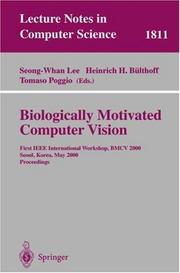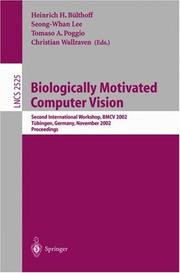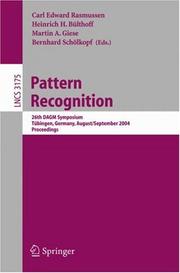| Listing 1 - 7 of 7 |
Sort by
|

ISBN: 0262700700 0262287609 0585090084 9780262287609 9780585090085 9780262700702 Year: 1999 Publisher: Cambridge (Mass.) MIT Press
Abstract | Keywords | Export | Availability | Bookmark
 Loading...
Loading...Choose an application
- Reference Manager
- EndNote
- RefWorks (Direct export to RefWorks)
The contributors bring a wide range of methodologies to bear on the common problem of image-based object recognition.
Differentiation (Cognition) --- Three-dimensional display systems --- Optical pattern recognition --- Computer vision --- Engineering & Applied Sciences --- Applied Physics --- 3-D display systems --- 3D display systems --- Display systems, Three-dimensional --- Information display systems --- Three-dimensional imaging --- Machine vision --- Vision, Computer --- Artificial intelligence --- Image processing --- Pattern recognition systems --- Cognition --- Optical data processing --- Pattern perception --- Perceptrons --- Visual discrimination --- Optical pattern recognition. --- Computer vision. --- Three-dimensional display systems.

ISBN: 3540675604 3540454829 Year: 2000 Publisher: Berlin, Heidelberg : Springer Berlin Heidelberg : Imprint: Springer,
Abstract | Keywords | Export | Availability | Bookmark
 Loading...
Loading...Choose an application
- Reference Manager
- EndNote
- RefWorks (Direct export to RefWorks)
It is our great pleasure and honor to organize the First IEEE Computer Society International Workshop on Biologically Motivated Computer Vision (BMCV 2000). The workshop BMCV 2000 aims to facilitate debates on biologically motivated vision systems and to provide an opportunity for researchers in the area of vision to see and share the latest developments in state-of-the-art technology. The rapid progress being made in the field of computer vision has had a tremendous impact on the modeling and implementation of biologically motivated computer vision. A multitude of new advances and findings in the domain of computer vision will be presented at this workshop. By December 1999 a total of 90 full papers had been submitted from 28 countries. To ensure the high quality of workshop and proceedings, the program committee selected and accepted 56 of them after a thorough review process. Of these papers 25 will be presented in 5 oral sessions and 31 in a poster session. The papers span a variety of topics in computer vision from computational theories to their implementation. In addition to these excellent presentations, there will be eight invited lectures by distinguished scientists on “hot” topics. We must add that the program committee and the reviewers did an excellent job within a tight schedule.
Vision --- Computer vision --- Visual cortex --- Neural networks (Computer science) --- Bionics --- Pattern Recognition, Visual --- Neural Networks (Computer) --- Artificial Intelligence --- Visual Cortex --- Mathematical Concepts --- Pattern Recognition, Physiological --- Visual Perception --- Occipital Lobe --- Pattern Recognition, Automated --- Biophysics --- Electronics --- Form Perception --- Computing Methodologies --- Biological Science Disciplines --- Cerebral Cortex --- Physics --- Perception --- Phenomena and Processes --- Information Science --- Space Perception --- Mental Processes --- Natural Science Disciplines --- Cerebrum --- Disciplines and Occupations --- Psychological Phenomena and Processes --- Telencephalon --- Psychiatry and Psychology --- Prosencephalon --- Brain --- Central Nervous System --- Nervous System --- Anatomy --- Neuroscience --- Human Anatomy & Physiology --- Health & Biological Sciences --- Computer simulation --- Area striata --- Striate area --- Striate cortex --- Eyesight --- Seeing --- Sight --- Computer science. --- Algorithms. --- Artificial intelligence. --- Image processing. --- Pattern recognition. --- Bioinformatics. --- Computational biology. --- Control engineering. --- Robotics. --- Mechatronics. --- Computer Science. --- Image Processing and Computer Vision. --- Artificial Intelligence (incl. Robotics). --- Pattern Recognition. --- Algorithm Analysis and Problem Complexity. --- Computer Appl. in Life Sciences. --- Control, Robotics, Mechatronics. --- Occipital lobes --- Senses and sensation --- Blindfolds --- Eye --- Physiological optics --- Computer vision. --- Optical pattern recognition. --- Computer software. --- Biology --- Artificial Intelligence. --- Data processing. --- Software, Computer --- Computer systems --- Optical data processing --- Pattern perception --- Perceptrons --- Visual discrimination --- AI (Artificial intelligence) --- Artificial thinking --- Electronic brains --- Intellectronics --- Intelligence, Artificial --- Intelligent machines --- Machine intelligence --- Thinking, Artificial --- Cognitive science --- Digital computer simulation --- Electronic data processing --- Logic machines --- Machine theory --- Self-organizing systems --- Simulation methods --- Fifth generation computers --- Neural computers --- Machine vision --- Vision, Computer --- Artificial intelligence --- Image processing --- Pattern recognition systems --- Optical data processing. --- Bioinformatics . --- Computational biology . --- Mechanical engineering --- Microelectronics --- Microelectromechanical systems --- Optical computing --- Visual data processing --- Integrated optics --- Photonics --- Computers --- Automation --- Control engineering --- Control equipment --- Control theory --- Engineering instruments --- Programmable controllers --- Bioinformatics --- Bio-informatics --- Biological informatics --- Information science --- Computational biology --- Systems biology --- Algorism --- Algebra --- Arithmetic --- Design perception --- Pattern recognition --- Form perception --- Figure-ground perception --- Optical equipment --- Data processing --- Foundations --- Pattern perception. --- Automatic control.
Book
ISBN: 940177238X 9401772398 Year: 2015 Publisher: Dordrecht : Springer Netherlands : Imprint: Springer,
Abstract | Keywords | Export | Availability | Bookmark
 Loading...
Loading...Choose an application
- Reference Manager
- EndNote
- RefWorks (Direct export to RefWorks)
Brain and Cognitive Engineering is a converging study field to derive a better understanding of cognitive information processing in the human brain, to develop “human-like” and neuromorphic artificial intelligent systems and to help predict and analyze brain-related diseases. The key concept of Brain and Cognitive Engineering is to understand the Brain, to interface the Brain, and to engineer the Brain. It could help us to understand the structure and the key principles of high-order information processing on how the brain works, to develop interface technologies between a brain and external devices and to develop artificial systems that can ultimately mimic human brain functions. The convergence of behavioral, neuroscience and engineering research could lead us to advance health informatics and personal learning, to enhance virtual reality and healthcare systems, and to “reverse engineer” some brain functions and build cognitive robots. In this book, four different recent research directions are presented: Non-invasive Brain-Computer Interfaces, Cognitive- and Neural-rehabilitation Engineering, Big Data Neurocomputing, Early Diagnosis and Prediction of Neural Diseases. We cover numerous topics ranging from smart vehicles and online EEG analysis, neuroimaging for Brain-Computer Interfaces, memory implantation and rehabilitation, big data computing in cultural aspects and cybernetics to brain disorder detection. Hopefully this will provide a valuable reference for researchers in medicine, biomedical engineering, in industry and academia for their further investigations and be inspiring to those who seek the foundations to improve techniques and understanding of the Brain and Cognitive Engineering research field.
Neurology --- Medicine --- Health & Biological Sciences --- Brain --- User-centered system design. --- Human-computer interaction. --- Neural computers. --- Diseases. --- Neural net computers --- Neural network computers --- Neurocomputers --- Computer-human interaction --- Human factors in computing systems --- Interaction, Human-computer --- Cognitive engineering (System design) --- Participatory design (System design) --- UCD (System design) --- Usability engineering (System design) --- User-centered design (System design) --- Brain diseases --- Medicine. --- Neurosciences. --- Bioinformatics. --- Neurobiology. --- Biomedicine. --- Computational Biology/Bioinformatics. --- Electronic digital computers --- Natural computation --- Artificial intelligence --- Human engineering --- User-centered system design --- User interfaces (Computer systems) --- System design --- Human-computer interaction --- Psychology, Pathological --- Neurosciences --- Bio-informatics --- Biological informatics --- Biology --- Information science --- Computational biology --- Systems biology --- Neural sciences --- Neurological sciences --- Neuroscience --- Medical sciences --- Nervous system --- Data processing

ISBN: 9783540001744 3540001743 3540361812 Year: 2002 Publisher: Berlin, Heidelberg : Springer Berlin Heidelberg : Imprint: Springer,
Abstract | Keywords | Export | Availability | Bookmark
 Loading...
Loading...Choose an application
- Reference Manager
- EndNote
- RefWorks (Direct export to RefWorks)
This book constitutes the refereed proceedings of the Second International Workshop on Biologically Motivated Computer Vision, BMCV 2002, held in Tübingen, Germany, in November 2002. The 22 revised full papers and 37 revised short papers presented together with 6 invited papers were carefully reviewed and selected from 97 submissions. The papers are organized in topical sections on neurons and features, motion, mid-level vision, recognition - from scenes to neurons, attention, robotics, and cognitive vision.
Vision --- Computer vision --- Visual cortex --- Vision par ordinateur --- Computer simulation --- Congresses. --- Congrès --- Neuroscience --- Human Anatomy & Physiology --- Health & Biological Sciences --- Area striata --- Striate area --- Striate cortex --- Eyesight --- Seeing --- Sight --- Computer science. --- Algorithms. --- Artificial intelligence. --- Computer graphics. --- Image processing. --- Pattern recognition. --- Bioinformatics. --- Computer Science. --- Image Processing and Computer Vision. --- Algorithm Analysis and Problem Complexity. --- Artificial Intelligence (incl. Robotics). --- Computer Graphics. --- Pattern Recognition. --- Bio-informatics --- Biological informatics --- Biology --- Information science --- Computational biology --- Systems biology --- Design perception --- Pattern recognition --- Form perception --- Perception --- Figure-ground perception --- Pictorial data processing --- Picture processing --- Processing, Image --- Imaging systems --- Optical data processing --- Automatic drafting --- Graphic data processing --- Graphics, Computer --- Computer art --- Graphic arts --- Electronic data processing --- Engineering graphics --- Image processing --- AI (Artificial intelligence) --- Artificial thinking --- Electronic brains --- Intellectronics --- Intelligence, Artificial --- Intelligent machines --- Machine intelligence --- Thinking, Artificial --- Bionics --- Cognitive science --- Digital computer simulation --- Logic machines --- Machine theory --- Self-organizing systems --- Simulation methods --- Fifth generation computers --- Neural computers --- Algorism --- Algebra --- Arithmetic --- Informatics --- Science --- Data processing --- Digital techniques --- Foundations --- Occipital lobes --- Senses and sensation --- Blindfolds --- Eye --- Physiological optics --- Computer vision. --- Computer software. --- Optical pattern recognition. --- Artificial Intelligence. --- Pattern perception --- Perceptrons --- Visual discrimination --- Software, Computer --- Computer systems --- Machine vision --- Vision, Computer --- Artificial intelligence --- Pattern recognition systems --- Optical data processing. --- Optical computing --- Visual data processing --- Integrated optics --- Photonics --- Computers --- Optical equipment

ISBN: 3540229450 3540286497 Year: 2004 Publisher: Berlin, Heidelberg : Springer Berlin Heidelberg : Imprint: Springer,
Abstract | Keywords | Export | Availability | Bookmark
 Loading...
Loading...Choose an application
- Reference Manager
- EndNote
- RefWorks (Direct export to RefWorks)
We are delighted to present the proceedings of DAGM 2004, and wish to - press our gratitude to the many people whose e?orts made the success of the conference possible. We received 146 contributions of which we were able to - cept 22 as oral presentations and 48 as posters. Each paper received 3 reviews, upon which decisions were based. We are grateful for the dedicated work of the 38 members of the program committee and the numerous referees. The careful review process led to the exciting program which we are able to present in this volume. Among the highlights of the meeting were the talks of our four invited spe- ers, renowned experts in areas spanning learning in theory, in vision and in robotics: – William T. Freeman, Arti?cial Intelligence Laboratory, MIT: Sharing F- tures for Multi-class Object Detection – PietroPerona,Caltech:TowardsUnsupervisedLearningofObjectCategories – StefanSchaal,DepartmentofComputerScience,UniversityofSouthernC- ifornia: Real-Time Statistical Learning for Humanoid Robotics – Vladimir Vapnik, NEC Research Institute: Empirical Inference WearegratefulforeconomicsupportfromHondaResearchInstituteEurope, ABW GmbH, Transtec AG, DaimlerChrysler, and Stemmer Imaging GmbH, which enabled us to ?nance best paper prizes and a limited number of travel grants. Many thanks to our local support Sabrina Nielebock and Dagmar Maier, who dealt with the unimaginably diverse range of practical tasks involved in planning a DAGM symposium. Thanks to Richard van de Stadt for providing excellent software and support for handling the reviewing process. A special thanks goes to Jeremy Hill, who wrote and maintained the conference website.
Image processing --- Optical pattern recognition --- Digital techniques --- Pattern Recognition. --- Image Processing and Computer Vision. --- Computer Graphics. --- Computer science. --- Algorithms. --- Artificial intelligence. --- Computer graphics. --- Image processing. --- Pattern recognition. --- Computer Science. --- Artificial Intelligence (incl. Robotics). --- Algorithm Analysis and Problem Complexity. --- Optical pattern recognition. --- Computer vision. --- Computer software. --- Artificial Intelligence. --- Software, Computer --- Computer systems --- Automatic drafting --- Graphic data processing --- Graphics, Computer --- Computer art --- Graphic arts --- Electronic data processing --- Engineering graphics --- AI (Artificial intelligence) --- Artificial thinking --- Electronic brains --- Intellectronics --- Intelligence, Artificial --- Intelligent machines --- Machine intelligence --- Thinking, Artificial --- Bionics --- Cognitive science --- Digital computer simulation --- Logic machines --- Machine theory --- Self-organizing systems --- Simulation methods --- Fifth generation computers --- Neural computers --- Machine vision --- Vision, Computer --- Artificial intelligence --- Pattern recognition systems --- Optical data processing --- Pattern perception --- Perceptrons --- Visual discrimination --- Optical data processing. --- Optical computing --- Visual data processing --- Integrated optics --- Photonics --- Computers --- Design perception --- Pattern recognition --- Form perception --- Perception --- Figure-ground perception --- Algorism --- Algebra --- Arithmetic --- Optical equipment --- Foundations --- Pattern perception.
Book

Year: 2004 Publisher: [Place of publication not identified] ACM Press
Abstract | Keywords | Export | Availability | Bookmark
 Loading...
Loading...Choose an application
- Reference Manager
- EndNote
- RefWorks (Direct export to RefWorks)
Computer graphics --- Information visualization --- Visual perception
Book

ISBN: 1581139144 Year: 2004 Publisher: ACM
Abstract | Keywords | Export | Availability | Bookmark
 Loading...
Loading...Choose an application
- Reference Manager
- EndNote
- RefWorks (Direct export to RefWorks)
| Listing 1 - 7 of 7 |
Sort by
|

 Search
Search Feedback
Feedback About UniCat
About UniCat  Help
Help News
News